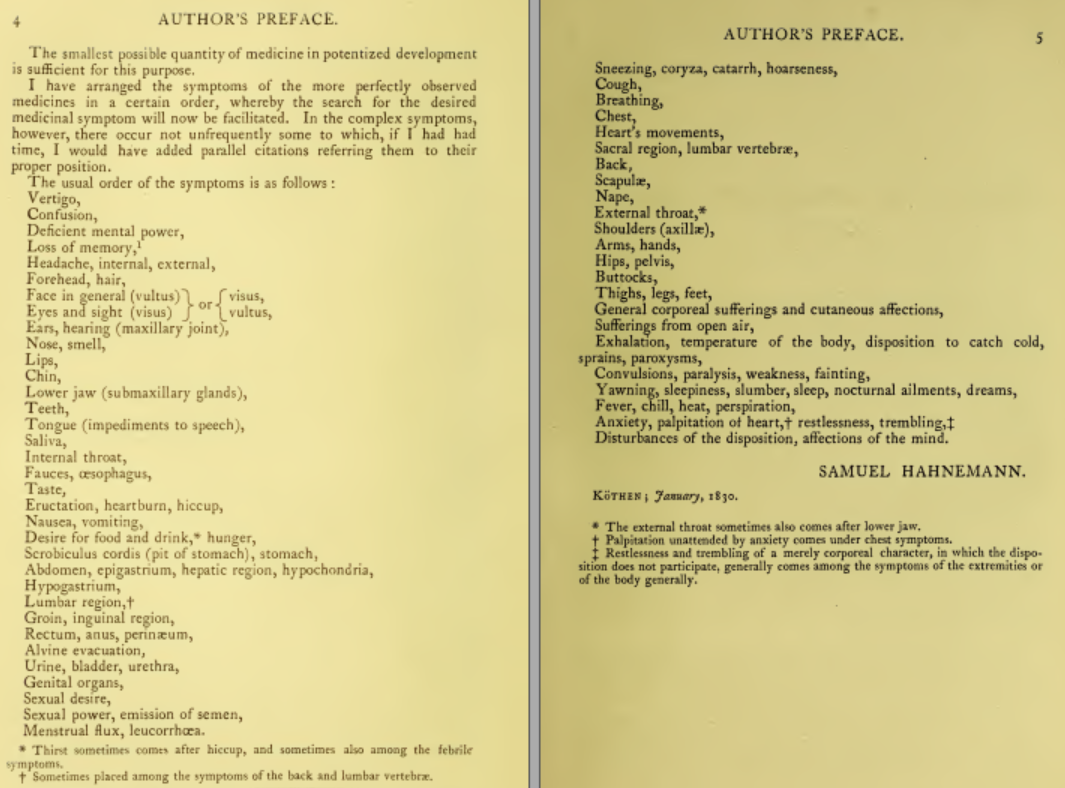Introduction to the materia medica
Homeopaths prescribe remedies based on the information compiled in materia medicas. These are books where many of the indications of a specific remedy are put. These works are not unique to homeopathy - at Hahnemann’s time, they were standard medical books. However, Hahnemann created ones that are more useful to us homeopathically, because they include the kinds of indications homeopaths use to prescribe. He wrote 3, but only two are still used: Materia Medica Pura and Chronic Diseases (Reine Arzneimittellehre and Die Chronischen Krankheiten in German, respectively).
Since he’s time, people have compiled many, many, many different materia medicas. In some ways this is good - more information, and information on newer remedies - but they are not always super accurate, nor do they say where their information came from. For that reason, I will focus on Hahnemann’s materia medicas here, especially since all the ones that came after follow the basic outline of his works.
Format:
For each remedy, Hahnemann has an introduction where he shares a bit on how the remedy is prepared, common indications, antidotes, and sometimes some philosophical tidbits (or full out rants). They are super interesting and helpful, so I highly recommend reading them.
After the introduction, he has a list of symptoms from primary sources. The primary sources are what make his materia medicas completely unique - to my knowledge, no other materia medica only cites primary sources. All others cite primary and secondary and tertiary…. all mixed up together. Not all materia medicas cite their sources either.
The list of symptoms follows the following order (quoted from the introduction to Hahnemann’s Materia Medica Pura, p4-5):
Vertigo,
Confusion,
Deficient mental power,
Loss of memory,
Headache, internal, external,
Forehead, hair,
Face in general
Eyes and sight (visus or vultus)
Ears, hearing (maxillary joint),
Nose, smell,
Lips,
Chin,
Lower jaw (submaxillary glands),
Teeth,
Tongue (impediments to speech),
Saliva,
Internal throat,
Fauces, oesophagus,
Taste,
Eructation, heartburn, hiccup,
Nausea, vomiting,
Desire for food and drink, hunger,
Scrobiculus cordis (pit of stomach), stomach,
Abdomen, epigastrium, hepatic region, hypochondria,
Hypogastrium,
Lumbar region,
Groin, inguinal region,
Rectum, anus, perinaeum,
Alvine evacuation.
Urine, bladder, urethra,
Genital organs,
Sexual desire,
Sexual power, emission of semen,
Menstrual flux, leucorrhoea.
Sneezing, coryza, catarrh, hoarseness,
Cough,
Breathing,
Chest,
Heart’s movements,
Sacral region, lumbar vertebrae,
Back,
Scapulae,
Nape,
External throat,
Shoulders (axillae),
Arms, hands,
Hips, pelvis,
Buttocks,
Thighs, legs, feet,
General corporeal sufferings and cutaneous affections,
Sufferings from open air,
Exhalation, temperature of the body, disposition to catch cold, sprains, paroxysms,
Convulsions, paralysis, weakness, fainting,
Yawning, sleepiness, slumber, sleep, nocturnal ailments, dreams,
Fever, chill, heat, perspiration,
Anxiety, palpitation of heart, restlessness, trembling,
Disturbances of the disposition, affections of the mind.
In Chronic Diseases (which was published after Materia Medica Pura), Hahnemann moved the “disturbances of the disposition, affections of the mind” (i.e. emotional changes) to the beginning - before vertigo. This schema, with emotional changes first, followed by the list above, has been the schema adopted by every materia medica in homeopathy since. I have never seen one that didn’t follow this, although there are minor changes based on what the author includes/excludes. For example, if there are no chest symptoms, the chest section is obviously omitted. But the benefit of this schema is that when you are looking for a specific symptom, you can quickly look to the appropriate section and find what you are looking for.
The language of Hahnemann is hard to understand, I know. I have spent 6 years at this point trying to read his Materia Medica Pura and Chronic Diseases, and only recently do I feel I am starting to really be able to understand it and use it well. But I do recommend finding a way to study this that works for you, because for the remedies these works contain, there are no materia medicas that are as accurate as Hahnemann’s - copying leads to errors, so errors commonly find their way into tertiary or quaternary sources. Furthermore, Hahnemann’s main objective was to be exceedingly accurate, and worked incredibly hard to portray how accurate every entry into his materia medica was. But that’s a story for another day….
